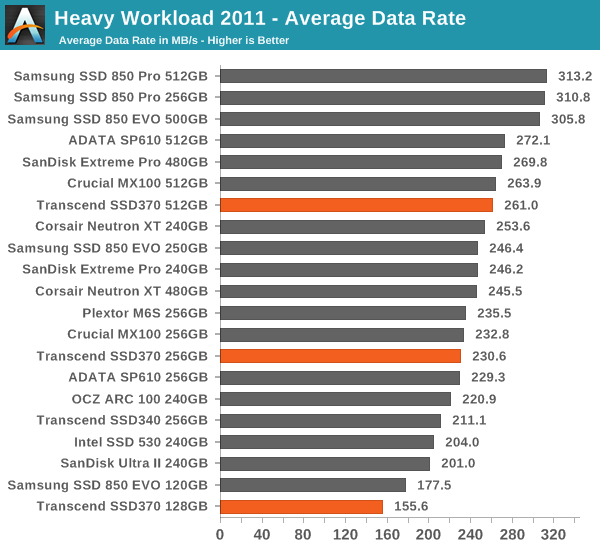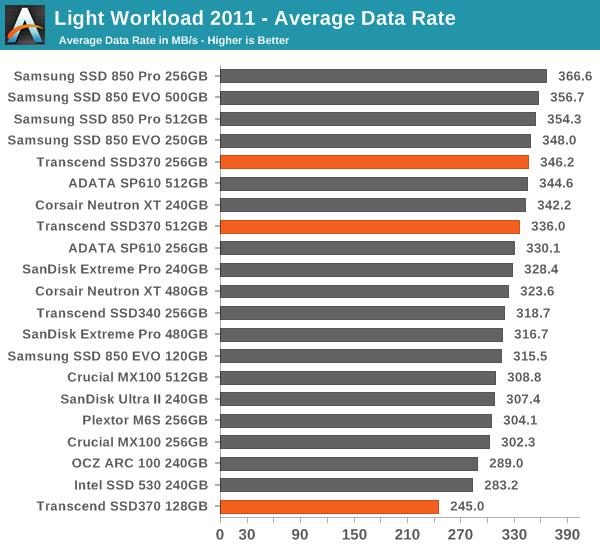Transcend SSD370 (128GB, 256GB & 512GB) Review
by Kristian Vättö on January 27, 2015 8:00 AM EST- Posted in
- Storage
- SSDs
- Transcend
- Silicon Motion
- SM2246EN
AnandTech Storage Bench 2011
Back in 2011 (which seems like so long ago now!), we introduced our AnandTech Storage Bench, a suite of benchmarks that took traces of real OS/application usage and played them back in a repeatable manner. The MOASB, officially called AnandTech Storage Bench 2011 – Heavy Workload, mainly focuses on peak IO performance and basic garbage collection routines. There is a lot of downloading and application installing that happens during the course of this test. Our thinking was that it's during application installs, file copies, downloading and multitasking with all of this that you can really notice performance differences between drives. The full description of the Heavy test can be found here, while the Light workload details are here.

The same story continues in our 2011 Workloads. The performance isn't 850 Pro level, but the SSD370 is competitive among other value-oriented drives. The performance of the 128GB model is a bit of a letdown, but that was expected since 128Gbit NAND has a severe impact on parallelism at 128GB and lower.











44 Comments
View All Comments
Hulk - Tuesday, January 27, 2015 - link
Perhaps I missed it but no mention/testing of endurance? All I see are manufacturer quoted numbers in the table.DanNeely - Tuesday, January 27, 2015 - link
Barring catastrophic failures, endurance testing a drive to destruction takes many months. Tech Report started torturing a set of 256GB drives in late 2013; as of last month 2 of the 6 drives were still running.http://techreport.com/review/27436/the-ssd-enduran...
Hulk - Tuesday, January 27, 2015 - link
I guess you don't read Anandtech much. Generally they run down the drive enough to move the counter down a few percent, then make a good estimate of endurance based on those numbers. I think it's very interesting and pretty much only Anandtech does it. Or used to do it.extide - Tuesday, January 27, 2015 - link
Maybe it's you that doesn't read AT that much ;) (Haha, I had to)They typically will only do that when they are testing drives with a new type of NAND that we haven't seen yet before, or testing some weird scenario, or something like that. Micron 20nm NAND is a well known entity at this point, and even though they are using custom firmware on this controller, it's performance and behavior seems very similar to the stock SMI firmware -- so basically there is nothing remarkable here. I am sure the endurance will be similar to most other drives with this type of NAND.
Kristian Vättö - Tuesday, January 27, 2015 - link
Right on the spot. I only do endurance testing with new NAND generations that we haven't seen before to figure out the P/E cycle rating. It takes days, possibly weeks, so there is no point in testing that with every drive. After all, the manufacturers' ratings still matter because once those are reached the warranty will be voided anyway, so my endurance tests aim to tell more about the NAND than the drive itself.Hulk - Tuesday, January 27, 2015 - link
Okay makes sense.I can admit when I'm wrong.
Hulk - Tuesday, January 27, 2015 - link
But wait. Does it take days or weeks to run down the counter 1 or 2 percent? That's all you need to get an estimate on actual endurance right?And isn't there variation in the NAND that each manufacturer buys for each line of drives? I'm talking about the binning and how endurance can vary for the same process.
Kristian Vättö - Tuesday, January 27, 2015 - link
The problem is finding the exact spot where the counter changes by 1 percent, so it usually takes at least a few percent worth of cycling to find that. Generally it takes a couple of days for client drives, but even then that time is away from testing other drives.You are correct that not every die is equal, but the P/E cycle rating is usually conservative to guarantee that all SSD-grade dies comply that spec. With binning and parameter trimming it's possible to get much more out of the dies though.
Hulk - Tuesday, January 27, 2015 - link
Wow. Thanks for the specific reply.Souka - Wednesday, January 28, 2015 - link
Just thought to share:I've fried 3 brand new SSDs in my torrent box over the past year. Granted two were 64GB, one 120GB, and they were pretty meh to begin with performance wise.
I knew the SSD wouldn't last, but didn't expect it to fail that quickly. Currently have an OLD 64GB Intel SLC (X25 I think) in for past few months...no issue yet.